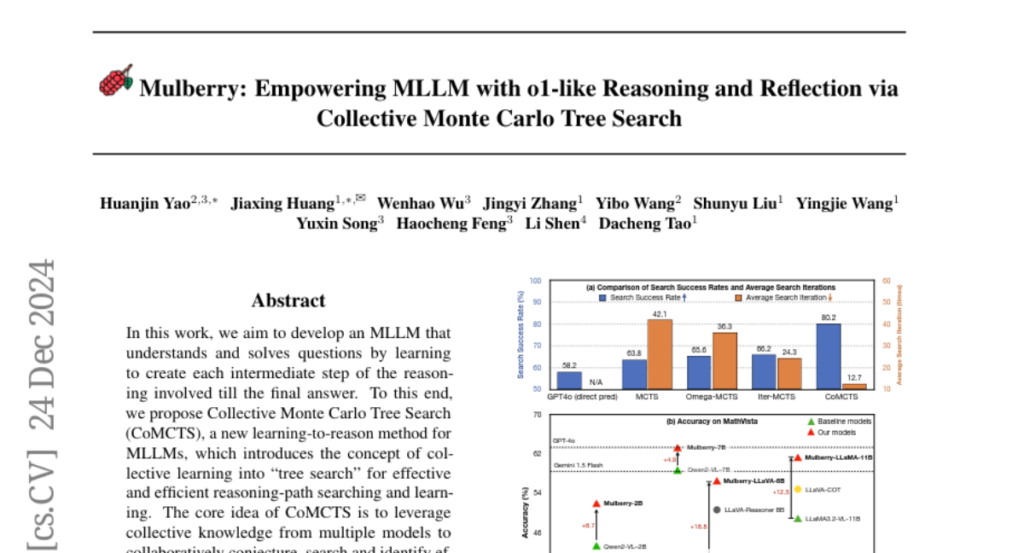AI Native Daily Paper Digest – 20241226

1. Token-Budget-Aware LLM Reasoning
🔑 Keywords: LLMs, Chain-of-Thought, Reasoning, Token Budget, Efficiency
💡 Category: Natural Language Processing
🌟 Research Objective:
– The study aims to enhance the efficiency of reasoning in large language models (LLMs) by proposing a framework that effectively balances token usage cost and reasoning effectiveness.
🛠️ Research Methods:
– A token-budget-aware reasoning framework is introduced, dynamically estimating token budgets based on reasoning complexity to guide the LLM reasoning process.
💬 Research Conclusions:
– The methodology successfully reduces token costs in Chain-of-Thought reasoning with minimal performance impact, providing a practical solution for optimizing LLM reasoning efficiency.
👉 Paper link: https://huggingface.co/papers/2412.18547

2. Mulberry: Empowering MLLM with o1-like Reasoning and Reflection via Collective Monte Carlo Tree Search
🔑 Keywords: MLLM, CoMCTS, reasoning, collective knowledge, Mulberry-260k
💡 Category: Knowledge Representation and Reasoning
🌟 Research Objective:
– The research aims to develop a multimodal large language model (MLLM) capable of solving questions by learning each intermediate step involved in reasoning.
🛠️ Research Methods:
– The study introduces Collective Monte Carlo Tree Search (CoMCTS), a learning-to-reason method that utilizes collective knowledge from multiple models for effective reasoning path searching.
💬 Research Conclusions:
– Extensive experiments showcase the superiority of the proposed methods on various benchmarks, demonstrating the effectiveness and efficiency of CoMCTS and the developed model, Mulberry.
👉 Paper link: https://huggingface.co/papers/2412.18319

3. PepTune: De Novo Generation of Therapeutic Peptides with Multi-Objective-Guided Discrete Diffusion
🔑 Keywords: Peptide therapeutics, Multi-objective optimization, PepTune, Discrete diffusion, Monte Carlo Tree Search
💡 Category: AI in Healthcare
🌟 Research Objective:
– The research aims to overcome the challenges in designing peptides that fulfill multiple objectives like binding affinity, solubility, and permeability by developing PepTune for multi-objective optimization.
🛠️ Research Methods:
– The study introduces PepTune, a model based on the Masked Discrete Language Model (MDLM) framework with a Monte Carlo Tree Search (MCTS) strategy to guide the generation of optimal peptide sequences.
💬 Research Conclusions:
– The MCTS-guided discrete diffusion is found to be an effective and versatile method for designing peptides that are optimized for numerous therapeutic properties, showcasing its potential in peptide therapeutics.
👉 Paper link: https://huggingface.co/papers/2412.17780

4. Video-Panda: Parameter-efficient Alignment for Encoder-free Video-Language Models
🔑 Keywords: video-language understanding, Spatio-Temporal Alignment Block, encoder-free, multi-frame videos, fine-grained feature extraction
💡 Category: Multi-Modal Learning
🌟 Research Objective:
– The paper aims to develop an efficient encoder-free approach to video-language understanding, achieving competitive performance with reduced computational overhead.
🛠️ Research Methods:
– Introduced the novel Spatio-Temporal Alignment Block (STAB) to process video inputs using only 45M parameters, without pre-trained encoders, and applied Local Spatio-Temporal Encoding for feature extraction, incorporating learned attention for efficient spatial downsampling.
💬 Research Conclusions:
– The proposed method achieves comparable or superior results to encoder-based approaches in video question answering benchmarks, delivering faster processing speeds and demonstrating effectiveness in fine-grained and temporal understanding.
👉 Paper link: https://huggingface.co/papers/2412.18609

5. WavePulse: Real-time Content Analytics of Radio Livestreams
🔑 Keywords: Radio Broadcasts, Real-time Analysis, Political Science, AI Systems and Tools, National Trends
💡 Category: AI Systems and Tools
🌟 Research Objective:
– To record, document, and analyze radio content in real-time for understanding information dissemination.
🛠️ Research Methods:
– Used WavePulse framework to monitor and analyze livestreams of 396 news radio stations during a three-month period, converting audio streams into time-stamped, diarized transcripts.
💬 Research Conclusions:
– Demonstrated how local issues interact with national trends, providing insights into information flow using radio content analysis.
👉 Paper link: https://huggingface.co/papers/2412.17998

6. How “Real” is Your Real-Time Simultaneous Speech-to-Text Translation System?
🔑 Keywords: Simultaneous Speech-to-Text Translation, Low Latency, Standardized Terminology, System Architectures
💡 Category: Natural Language Processing
🌟 Research Objective:
– This paper aims to address the limitations in current Simultaneous Speech-to-Text Translation (SimulST) research by illuminating existing challenges and proposing standardized terminology and taxonomy.
🛠️ Research Methods:
– Conduct an extensive literature review of 110 papers to analyze current trends and issues in SimulST, and present a framework for improved study.
💬 Research Conclusions:
– The study provides recommendations and future directions to enhance the applicability of SimulST research in real-world contexts, focusing on evaluation frameworks and system architectures.
👉 Paper link: https://huggingface.co/papers/2412.18495
